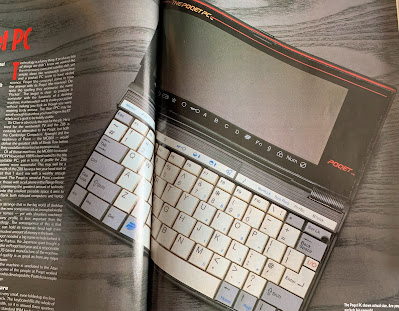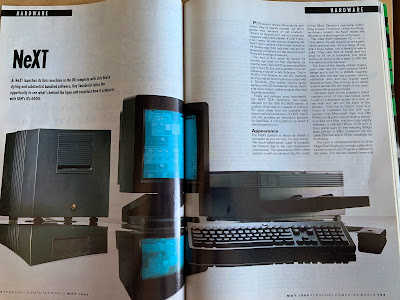Some readers may recall my recent Computer Shopper post and I mentioned that I was also an avid reader of Personal Computer World. As luck (and eBay) would have it, I managed to get my hands on a couple of issues of PCW from 1990 which I distinctly recall buying back in the day. I thought it would be handy to have a perusal and see how things had changed in the two years since that fourth issue of Shopper.
PCW was always a magazine with a decent production and printing budget, and it's plain to see here that it has a certain level of quality that the cover price of £1.50 justifies. You have perfect binding and colour on most of the 330 pages - that page count also makes it quite a beefy publication too. As you can see from the front covers, PCW had already been around quite a while, these issues being numbers 5 and 8 from volume 13.
 |
| You've got to pick a Poqet or two, oohhhhh, you've got to pick a Poqet or two... |
Let's look at May first, and that cover machine! That, gentle reader, was a device that I hankered for even after it was no longer available. There was no chance in hell of me ever getting one - the Poqet PC retailed at £1,350! Still, it's enough to attract the passing browser in Smiths or Menzies (the latter was still a thing back then!). The sub-headlines mention the NeXT, Apple's Mac IIfx and the exciting technology of colour LCD's explained.
 |
| Tis the future, I tell ye... |
One thing that is immediately apparent since 1988 is that there are more computer companies selling directly to the customer. Mesh, Multiplex and Dan Technology are just three of the more familiar names that early 90's buyers would see. Oh, there are still plenty of resellers for IBM, Olivetti and Amstrad, but the rise of the independent PC builder has begun.
 |
| You can have it in any colour... as long as it's beige... |
After the usual news and comment sections, we get the first hardware review, and it's the Poqet PC. Capable but pricy, the reviewer is not entirely sure where it fits in with the typical business user for the money, even with the convenience of such handy portability. Next up is the Mac IIfx and... far cough! How much??? I get it, it's running a 68030 at 40MHz, with 68882 maths co-processor. 4MB of RAM and and 80MB hard drive (heady stuff for the day, admittedly), but even with that colour monitor and keyboard - £7,800!!!
 |
| It's NeXTy and it knows it... (sorry) |
Moving swiftly on, let's look at the NeXT system, 'cos that's only... £10k with a mono monitor??? That truly was a beast of a machine - but £10k... not even sure if that includes VAT. If not, add another grand and a half... Mac System 7 gets a look in, and that article on colour LCD's is both quaint and interesting. Hewlett-Packard's Laserjet III is also reviewed, offering tremendous value for £1,999(!)
For RISC OS fans, there's four pages dedicated to the Concept Integrated Office System, an Archimedes-based solution for document processing, a review of Deluxe Paint IIe, and then the regulars that encompasses various workshops. reviews and topic specific columns. Overall, a good issue with a wide range of articles. It's also of note that there are no group reviews of products - they would become a feature of most magazines as the 90's progressed.
 |
| Tis not the future, of that I am certain... |
August now, and Commodore's great hope for multimedia fans gets the front cover. Whilst the article is very positive about the CDTV and its future, history has taught us that this machine had a very different destiny. The news section has a piece on IBM's introduction of the PS/1 range of consumer machines. No idea what was happening at Big Blue at the time, but their product designers were definitely on something as the PS/1 is a damn ugly little thing.
 |
| Oh, the humanity!!! |
 |
| The Tower of Power!!! |
Compaq's SystemPro is the main benchtest machine for this month and when you think tower of power, this is pretty much what should come to mind for the time. Entry level price was about £12k, the review system (2 x 386 33MHz processors, a 387 maths co-processor, 12MB of RAM, a 5.25" and a 3.5" floppy drive, a 520MB tape streamer, two (count 'em) 420MB hard drives and a 14' VGA monitor) was £30k. By this point, I was starting to wonder if PCW covered anything that didn't start at four figures. Seems not, as far as these issues are going.
 |
| Shiny, just not very popular. |
The next hardware review is of the Acorn R260, part of their ill-fated attempt at the Unix market. But hey, two Acorn pieces in two issues, they were really getting about! This ARM3 machine with 8MB of RAM and a 100MB hard drive could have been yours for £3k. There are other articles on the likes of voice control, the Asymmetric ToolBook programming environment and the presentation package SlideWriter Plus - all very serious, though the Screenplay section does have a look at the new Atari Lynx - won't somebody think of the batteries???
 |
| 386's were not cheap! I shall spare you the horror of the 486's on the next page! |
As noted with the Computer Shopper post, I'll be covering advertising and pricing of the period in the near future but just look at the prices being advertised by Viglen. A mono 20MHz 386 would set you back £1,699 ex VAT. Colour was £1,999. Even a mono 286 would cost you £869 ex VAT. Prices were starting to drop, albeit slowly, and the explosion of manufacturers were helping with price competition. There again, an Atari 520ST-FM was £299 inc VAT, and the 1040ST-FM £499. You needed a TV or a monitor but PC's were still expensive for anything other than an 8086/88.
Personal Computer World is very different in tone and style from the cheaper Computer Shopper (as noted by the May issue proclaiming the award of Technology Journal of the Year), but is equally informative and the two titles complement each other well. There was definitely balance to be had by reading both if you could at the time. In a couple of weeks, I'll be having a look at another publication of that period, What Personal Computer, and how yet another PC-centric magazine tried to differentiate itself from the competition.

No comments:
Post a Comment